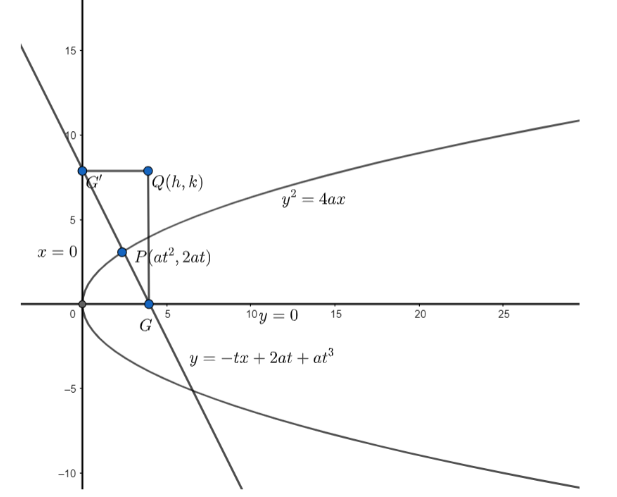Question
Question: The normal at any point \[P\] meets the axis in \[G\] and the tangent at the vertex in \[{{G}^{'}}\]...
The normal at any point P meets the axis in G and the tangent at the vertex in G′. If A be the vertex and the rectangle AGQG′ be completed, prove that the equation of locus of Q is
x3=2ax2+ay2
Solution
Hint:Here we use the property of a rectangle that the mid-points of the diagonals of a rectangle are the same .
Let’s consider the equation of the parabola to be y2=4ax. So, its vertex is A(0,0).
We know , any point on the parabola , given by the equation y2=4ax, can be written as P(at2,2at).

Now , we will find the equation of normal to the parabola at P.
We know , the equation of the normal to the parabola in parametric form is given as
y=−tx+2at+at3
So, the equation of normal at P can be written as
y=−tx+2at+at3....(i)
Now , we know , the axis of the parabola is y=0.
We need to find the point of intersection of the normal to the parabola and the axis of the parabola .
To find the point of intersection of normal and the axis , we will substitute y=0 in equation (i).
On substituting y=0 in equation (i) , we get
0=−tx+2at+at3
⇒x=2a+at2
So , the coordinates of G are (2a+at2,0).
Now , we know , tangent to the parabola at vertex is given by the equation x=0.
So , the point of intersection of normal and tangent at vertex can be found by substituting x=0in (i).
On substituting x=0in (i), we get
y=2at+at3
So, G′=(0,2at+at3)
Now , since we need to find the locus of Q, let Q=(h,k).
Now , it is given that AGQG′is a rectangle.
We know the diagonals of a rectangle bisect each other.
So , the midpoint of the diagonals AQ and GG′ is the same.
Now, we know that the coordinates of the midpoint of the line joining two points (x1,y1) and (x2,y2) is given as: (2x1+x2,2y1+y2)
So, midpoint of AQ=(20+h,20+k)
=(2h,2k)....(ii)
Midpoint of GG′=(22a+at2+0,20+2at+at3)
=(22a+at2,22at+at3)....(iii)
Comparing (ii) with (iii),
2h=22a+at2⇒h=2a+at2....(iv)
2k=22at+at3⇒k=2at+at3....(v)
On dividing (v)by (iv), we get
hk=2a+at22at+at3
⇒hk=t
Now, let’s substitute t=hkin (iv). We get ,
h=2a+a(hk)2
⇒h=h22ah2+ak2
Or, h3=2ah2+ak2........equation(vi)
Now, to find the locus of Q(h,k), we will substitute (x,y)in place of (h,k) in equation (vi)
So, the locus of Q(h,k) is x3=2ax2+ay2
Note: Vertex of y2=4axis (0,0).
Tangent at vertex is x=0
Equation of the axis is y=0.
Students generally get confused between the equation of tangent at vertex and the equation of axis.
